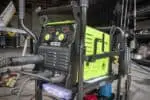Welding usually requires the use of gas in order to generate a gas shield to protect your weld from oxidation. Shielding gas allows a welder to make contact with the metals without being affected by other particles or pollutants in the environment.
And if you want your welding work to go on smoothly, full gas tanks are necessary because if you run out of gas, you will have a lot of hassle while welding.
You can check the pressure and flow gauges on welding tanks that can assist you in detecting whether your tank is empty or full. When these gauges reach a specific degree of depletion, you should make sure to replenish your tanks so that you can have a smooth welding process.
All types of welding, ranging from oxy-fuel, as well as Metal Inert Gas (MIG) and Tungsten Inert Gas (TIG) require the use of gas while welding.
To make sure your weld is free from corrosion and oxidation, all welding techniques require gas to form a shielded arc. Depending on the type of welding procedure employed, several gases can be used.
For oxy-fuel welding, oxygen and a fuel gas like acetylene or propane can be used. MIG requires carbon dioxide, argon, or helium, whereas TIG requires the use of pure argon.
Why is it important for you to check the level of welding gas from time to time?
Running out of welding gas may be both hazardous and inefficient for you while you are working. Contaminants from the environment might enter the weld and interfere with your finished weld which will mess up the weld puddle and allow air into the weld which will hamper the quality of your weld.
Therefore, keeping your tanks filled will keep you prepared and will also allow you to finish your welding project cleanly and safely.
Insufficient gas may lead to:
1.) Spatter- You may encounter spatter as a result of lack of shielding gas. You will encounter various small metal splashes surrounding the welding puddle.
2.) Weld puddle with air bubbles- When there is no gas present, the weld consistency changes. These external contaminants will interact with the weld puddle, causing irregularities in the process.
3.) Irregular welds/holes- You could make holes in the metal you’re dealing with. The weld will be degraded, and you may be able to see through the metal you’re working with.
4.) More smoking/sparking- You may observe more smoke and sparking than with a standard weld due to lack of gas.
How long does welding gas last?
The life of a welding gas is determined by the following factors:
1.) The welder’s flow rate: Seasonal welders employ a lower flow rate than novices, resulting in a variance in welding gas duration and quantity.
2.) The working environment: Windy environments necessitate a greater flow rate to keep the shielding gas around the weld and prevent air bubbles from entering.
3.) The types of welding machines used: Welders who use equipments that dispense gas whether the machine is turned on or off always have a shorter gas span.
How to check the amount of gas in your welding tank?
There are a few easy ways to tell if it’s time to replace a tank:
• Check the pressure gauges on the tank and the hoses.
• Weigh the gas bottle shield.
• Notes left from the most recent use.
The tank pressure gauge is in charge of indicating how full the tank is, therefore always read the gauge to check the status of the welding tank.
Take note of the pressure in your tank when it is full, it should show 1000 psi. And it will be halfway empty when it reaches 500 psi.
Use this approach to discover how much gas is remaining.
There are a few factors to keep in mind when inspecting these gauges:
• It is possible that the gauge is not always correct.
• Gauges do not always decline at the same rate.
• Gauges will differ in terms of both quality and sensitivity. The majority of regulators with linked gauges are more guesses than actual data.
When is it accurate for you to change your gas tank?
To keep your welding work going smoothly, you should be aware of when your tank is full or empty. There are a few ways to tell whether your tank is nearly empty.
While these techniques cannot provide a precise number, they will assist you in determining when it is time to replace a tank.
-
-
- Examine the gauges.
- Weighing the tank is an option.
- The hot water test.
- Notes from the last use.
-
A welding tank will feature a regulator which will regulate the flow of gas out of the tank and pressure gauges. And looking at these gauges can give you a decent idea of how much gas you have left.
Weight is another method to know whether your tank is empty. If you are aware of the weights of an empty tank and a full tank, you can calculate the difference and gauge by just checking the weight.
Another method to check the status of your gas tank is the hot water test. Pour hot water over the exterior of your welding tank in a dish or pitcher. Feel the tank’s outside. You will notice a change in temperature.
You may notice a temperature difference between a major percentage of your tank (especially the empty area) and the area that contains the remaining gas.
This works nicely for argon tanks and provides an approximate estimate of how much gas is remaining.
Also, taking notes can assist you in determining how much gas you consume over time as well as how your gauge functions. Keeping these elements in mind will assist you to avoid running out the next time.
How to refill your empty gas tank?
You can always take your empty tank to the nearby supply and get it full there. It is a safe method that can be handled by experienced people.
They will simply take your empty tank, as long as it is in proper functioning order, and replace it with a new full one.
You can also purchase extra tanks so that you are always prepared and have a backup.
There are several critical safety measures to follow when storing gas cylinders, read below:
• Always keep the valves protective caps on.
• Make sure the storage area is well-ventilated.
• Store the tank in an upright manner with no chance of being knocked over.
• Store welding tanks away from direct heat or sunshine.
• Keep cylinders away from the ground, snow, ice, water, and corrosion (keep away from all extreme elements).
Conclusion
Shielding gases are an important aspect for your welding projects. They provide a protective layer for your metals which safeguards them from corrosion and rust.
Therefore, you have to make sure that your tank is always full so that you can work with full efficiency.








